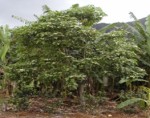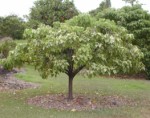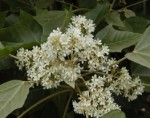Scientific Name: Aleurites mollucana
Also Known As: Candlenut Tree
Polynesian Introduction: All of HI except Kaho’olawe
Description: Large trees up to 60 feet tall easily distinguished from far distances by its light green foliage. Also recognizable are its distinct leaf shapes, beautiful flower clusters and familiar fruit. Honestly, if you don’t easily recognize kukui by now, you need to get out more.
Distribution: This is a Polynesian introduced tree now naturalized and becoming increasingly invasive on all of the main islands in the mesic forests from sea level to about 2000 ft. in elevation.
Cultural Uses: One of the most used plants in Hawaiian culture, nearly every part of the kukui had a use. Primarily the seeds were strung on a palm midrib and burned to make candles hence the name candlenut tree. In addition the juice from the husk of the fruit was used to make a black dye while the bark around the roots made a similar dye for canoes. Tree resins and sap were used medicinally and for glue while the nuts were roasted and made into a delicious relish called ‘inamona. The seeds, leaves and flowers can also be made in to lei.
Landscape Uses and Care: Kukui can get big so make sure you allow for lots of room around this tree. It is extremely easy to grow having few pests if any and needing hardly any water once established in the ground. Just make sure to pick up as many of the fallen seeds as possible or else they’ll germinate all over your garden.
Extra Info: Because we have become so technologically advanced here in Hawai’i we no longer use kukui as much as we used to so now it is becoming more and more dominant in our mesic forests often shading and crowding out a lot of other native plants that would have otherwise thrived there. We need to get back to our roots and continue to use kukui as we did in the past primarily so that it won’t out compete its native neighbors but also to continue to preserve our cultural history.
Kukui









